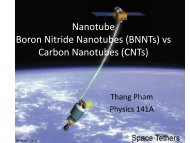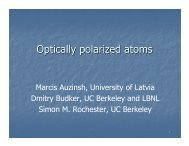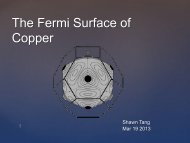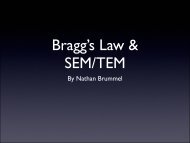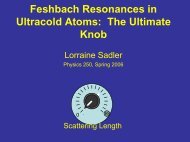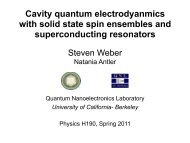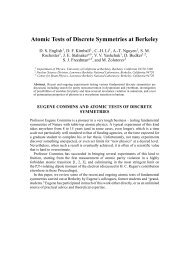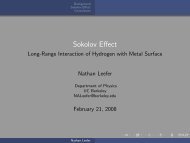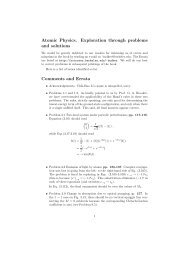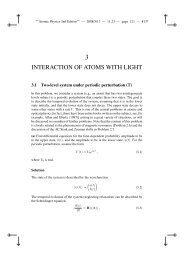Resonant nonlinear magneto-optical effects in atomsâ - The Budker ...
Resonant nonlinear magneto-optical effects in atomsâ - The Budker ...
Resonant nonlinear magneto-optical effects in atomsâ - The Budker ...
You also want an ePaper? Increase the reach of your titles
YUMPU automatically turns print PDFs into web optimized ePapers that Google loves.
9<br />
can be used for studies of collisional perturbations of<br />
Rydberg states with much greater precision than that<br />
of earlier photoabsorption experiments.<br />
4. Gas lasers<br />
Magneto-<strong>optical</strong> rotation of a weak probe light pass<strong>in</strong>g<br />
through a gas discharge is a useful tool for study<strong>in</strong>g<br />
amplify<strong>in</strong>g media <strong>in</strong> gas lasers. Early examples of this<br />
are the papers by Aleksandrov and Kulyasov (1972) who<br />
observed large rotations <strong>in</strong> a 136 Xe discharge and by Menzies<br />
(1973) who determ<strong>in</strong>ed population and polarization<br />
relaxation rates of the Ne levels mak<strong>in</strong>g up the 3.39 µm<br />
laser transition. <strong>The</strong> technique is applicable to transitions<br />
which exhibit light absorption as well as amplification<br />
depend<strong>in</strong>g on particular population ratios. S<strong>in</strong>ce<br />
the Faraday angle is proportional to the population difference<br />
for the two levels of a transition and changes sign<br />
when population <strong>in</strong>version is achieved, such studies allow<br />
precise determ<strong>in</strong>ation of population differences and their<br />
dependencies on parameters such as gas pressure and discharge<br />
current. An example is the work of W<strong>in</strong>iarczyk<br />
(1977) who studied the 632.8-nm Ne l<strong>in</strong>e. Due to its sensitivity,<br />
this method is useful for optimiz<strong>in</strong>g the efficiency<br />
of gas lasers, particularly those utiliz<strong>in</strong>g weak transitions.<br />
5. L<strong>in</strong>e identification <strong>in</strong> complex spectra and search for “new”<br />
energy levels<br />
We have already mentioned the utility of <strong>magneto</strong><strong>optical</strong><br />
rotation for identification of molecular spectra<br />
and for dist<strong>in</strong>guish<strong>in</strong>g atomic resonances from molecular<br />
ones. Another, more unusual, application of Faraday<br />
rotation spectroscopy was implemented by Barkov<br />
et al. (1989b, 1987, 1988b). <strong>The</strong>y were look<strong>in</strong>g for <strong>optical</strong><br />
magnetic-dipole transitions from the ground term of<br />
atomic samarium to the levels of the first excited term of<br />
the same configuration whose energies were not known.<br />
A study of the spectrum revealed hundreds of transitions<br />
that could not be identified with the known energy levels<br />
(most of these were due to transitions orig<strong>in</strong>at<strong>in</strong>g from<br />
thermally populated high-ly<strong>in</strong>g levels). Draw<strong>in</strong>g an analogy<br />
with <strong>in</strong>frared transitions between the ground term<br />
levels for which unusually small pressure broaden<strong>in</strong>g had<br />
been observed by Veden<strong>in</strong> et al. (1986, 1987), Barkov<br />
et al. predicted small pressure broaden<strong>in</strong>g for the soughtafter<br />
transitions as well. <strong>The</strong>y further noticed that <strong>in</strong><br />
the limit of γ ≫ Γ D (where γ and Γ D are the Lorentzian<br />
and Doppler widths, respectively), the peak Faraday rotation<br />
is ∝ γ −2 (<strong>in</strong> contrast to absorption, for which the<br />
amplitude is ∝ γ −1 ). In fact, at high buffer gas pressures<br />
(up to 20 atm), the <strong>magneto</strong>-<strong>optical</strong> rotation spectra<br />
showed that almost all transitions <strong>in</strong> the spectrum<br />
were so broadened and reduced <strong>in</strong> amplitude that they<br />
were practically unobservable. <strong>The</strong> spectrum consisted<br />
of only the sought-after transitions, which had unusually<br />
small pressure broaden<strong>in</strong>g.<br />
6. Applications <strong>in</strong> parity violation experiments<br />
Magneto-<strong>optical</strong> <strong>effects</strong> have played a crucial role <strong>in</strong><br />
experiments measur<strong>in</strong>g weak-<strong>in</strong>teraction <strong>in</strong>duced parityviolat<strong>in</strong>g<br />
<strong>optical</strong> activity of atomic vapors. 9 Parityviolat<strong>in</strong>g<br />
<strong>optical</strong> activity is usually observed <strong>in</strong> the absence<br />
of external static fields near magnetic-dipole (M1)<br />
transitions with transition amplitudes on the order of a<br />
Bohr <strong>magneto</strong>n. <strong>The</strong> magnitude of the rotation is typically<br />
10 −7 rad per absorption length for the heavy atoms<br />
(Bi, Tl, Pb) <strong>in</strong> which the effect has been observed.<br />
<strong>The</strong> Macaluso-Corb<strong>in</strong>o effect allows calibration of the<br />
<strong>optical</strong> rotation apparatus by apply<strong>in</strong>g a magnetic field<br />
to the vapor. On the other hand, because the parityviolat<strong>in</strong>g<br />
<strong>optical</strong> rotation angles are so small, great care<br />
must be taken to elim<strong>in</strong>ate spurious magnetic fields, s<strong>in</strong>ce<br />
sub-milligauss magnetic fields produce Macaluso-Corb<strong>in</strong>o<br />
rotation comparable <strong>in</strong> magnitude to the parity-violat<strong>in</strong>g<br />
rotation, albeit with a different l<strong>in</strong>eshape. <strong>The</strong> lack of<br />
proper control over spurious magnetic fields apparently<br />
was a problem with some of the early measurements of<br />
parity-violat<strong>in</strong>g <strong>optical</strong> activity <strong>in</strong> the late 1970s whose<br />
results were <strong>in</strong>consistent with subsequent more accurate<br />
measurements. 10<br />
<strong>The</strong> orig<strong>in</strong> of the parity-violat<strong>in</strong>g <strong>optical</strong> rotation lies<br />
<strong>in</strong> the mix<strong>in</strong>g, due to the weak <strong>in</strong>teraction, of atomic<br />
states of opposite parity, 11 which leads to an admixture<br />
of an electric-dipole (E1) component to the dom<strong>in</strong>ant<br />
M1 amplitude of the transition. <strong>The</strong> observed effect<br />
is the result of the <strong>in</strong>terference of the two components<br />
of the amplitude. In general, there is also an electric<br />
quadrupole (E2) component of the transition amplitude.<br />
However, there is no net contribution from E1–E2 <strong>in</strong>terference<br />
to the parity-violat<strong>in</strong>g <strong>optical</strong> rotation, s<strong>in</strong>ce the<br />
effect averages to zero for an unpolarized atomic sample.<br />
Nevertheless, knowledge of the E2 contribution is<br />
crucial for accurate determ<strong>in</strong>ation of the parity-violat<strong>in</strong>g<br />
amplitude, as it affects the sample absorption and the<br />
Macaluso-Corb<strong>in</strong>o rotation used for calibration. In addition,<br />
this contribution is important for <strong>in</strong>terpretation of<br />
the parity-violation experiments, s<strong>in</strong>ce the E2/M1 ratio<br />
can serve as an <strong>in</strong>dependent check of atomic theory. Fortunately,<br />
<strong>in</strong>vestigation of Macaluso-Corb<strong>in</strong>o l<strong>in</strong>eshapes<br />
allows direct determ<strong>in</strong>ation of the E2/M1 ratio (Bogdanov<br />
et al., 1986; Majumder and Tsai, 1999; Roberts<br />
et al., 1980; Tregidgo et al., 1986). <strong>The</strong>se measurements<br />
exploit the difference <strong>in</strong> the selection rules for these two<br />
9 See, for example, a review of early experiments by Khriplovich<br />
(1991), and more recent reviews by Bouchiat and Bouchiat<br />
(1997) and <strong>Budker</strong> (1999).<br />
10 <strong>The</strong> most accurate <strong>optical</strong> rotation measurements to date<br />
(Meekhof et al., 1995; Vetter et al., 1995) have reached the level<br />
of uncerta<strong>in</strong>ty of ∼1% of the magnitude of the effect.<br />
11 Parity-violat<strong>in</strong>g <strong>in</strong>teractions mix states of the same total angular<br />
momentum and projection. As a consequence of time-reversal<br />
<strong>in</strong>variance, the mix<strong>in</strong>g coefficient is purely imag<strong>in</strong>ary, which is<br />
the orig<strong>in</strong> of the chirality that leads to <strong>optical</strong> rotation.





